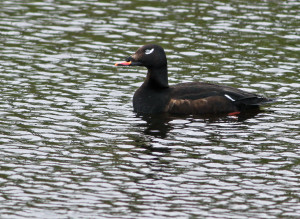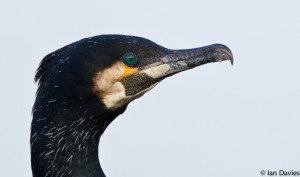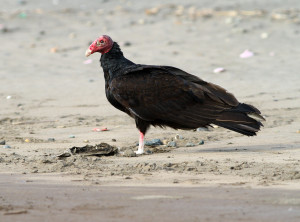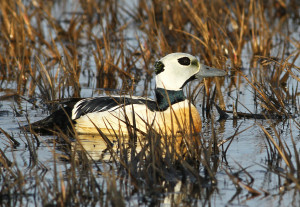The Toughest Birds to Record in North America

If you asked most people to list the toughest birds in the ABA area, the list would be a who’s who of hard to find, difficult to access, and shy species. It might be a list peppered with species requiring a trip to some remote Bering Sea island, or those calling for standing in the bitter cold on a high mountain pass in the middle of the night. But ask a recordist about the toughest birds in the ABA area and you’ll get a very different list. Most of the species that I talk about below aren’t really “hard” birds to see. Some of them can be downright common in the right areas. But what makes a bird hard to record can be quite different than what makes it hard to find. True, some of the species below are considered “tough” because of where they’re located – if you could get yourself to the right remote arctic island and you’d get all the recordings you want within a few hours. It’s the getting there that’s tricky. But most of the others are “tough” because they just don’t like to make noise. Or because they only make noise in situations that are hard for the average sound recordist to capture.
For the purposes of this list I decided not to include pelagic species. Otherwise most of the list would be filled with tubenoses, alcids, and other birds that most of us only see while puking our guts out on the open seas. I also don’t include any vagrants – to be included on the list the bird must be regular in the ABA. Finally I didn’t include Gray-headed Chickadee just because, well, I figure that species is a given. So below I’ve listed, in a (very) rough taxonomic order, 11 species that I would place on the “toughest to record” ranking for North America:
White-winged Scoter. Clearly this isn’t a rare or tough bird. So what gives?! Well, ocean ducks in general aren’t the easiest species to record. But with most of them, get yourself in the right spot and you can usually get something. That something may only be a quack or two, or it could be a bizarre and cool-sounding display. But with White-winged Scoter that right spot seems to be especially hard to find. I personally have never heard one vocalize on the wintering grounds. And this past summer I spent quite a bit of time trying to record them on the breeding grounds, and even then only heard them on one occasion! Luckily I was able to record said occasion. In general, though, White-winged Scoter seems be one of the toughest “common” species to come to grips with, aurally.
|
|
Spectacled and Steller’s Eiders. These two probably won’t come as a surprise – even without taking into account their vocals neither is a particularly easy species to find, unless you get to their high arctic breeding grounds. But unlike many other remote arctic species, neither of these birds are easy to record even when you do get there. The male displays in both species are very poorly understood, and even the female calls are rarely recorded. Like many ocean ducks, these two eiders probably do most of their displaying on the wintering grounds, which (especially in the case of Spectacled) makes for tough recording conditions to say the least! On the breeding grounds I have heard Steller’s Eiders a couple of times (over dozens of observations), and Spectacled exactly once (over 20 or so occasions). Definitely not easy birds to record.
Ross’s Goose. This diminutive white honker is probably unique in its place on this list. It isn’t here because its hard to find. Nor is it here because it isn’t very vocal. Its here because of the existence of it’s bigger, more common, usually noisier, and typically more annoying cousin – Snow Goose. Finding a pure flock of Ross’s Geese is a challenge to say the least. Central California is probably your best bet, but given the dearth of recordings available for this species it can’t be easy even there. I personally haven’t had the chance to go try to record this species, but I expect a challenge whenever I do make the attempt. The way around the pesky issue of flock purity would be to go to the breeding grounds in Nunavut. Unfortunately “Nunavut” and “inexpensive trip” are not terms usually used together.

Great Cormorant. This species illustrates another type of entrant to my list of toughies. I would be willing to bet that,under the right circumstance, Great Cormorants make quite a bit of noise. And finding them isn’t hard, nor is finding them away from other noisy species. But finding them when they are vocalizing is another question entirely. Most cormorants are almost entirely silent away from their breeding colonies, so it would take getting out onto the right rock in the Gulf of Maine to get a recording of this one. And unfortunately, almost all of those are off limits to lowly sound recordists.
Brandt’s Cormorant. Ditto to all of the above, but on a different coast. The Pacific has no shortage of cormorant variety, but this species seems to be especially quiet (even more so than Pelagic Cormorant, which already has a reputation of being a quiet bird). Unlike Great, though, getting to a Brandt’s colony is (slightly) easier. Still not a cinch though!
American White Pelican. You’d think that with such big mouths, Pelicans would be loud birds. Nothing could be further from the truth! As adult birds, Pelicans are some of the quietest species on the planet. The reason Brown Pelican isn’t on this list is that there are several places you can stand near their nests in Florida and record the quite noisy nestlings, but even there you aren’t likely to get the adults saying anything. But for their White cousins, I am not aware of any place you can easily access a nesting colony. The only time I have ever heard the species was when I had special access to a colony in Colorado.
Ross’s and Ivory Gulls. Remember when I talked about getting to the right arctic island and getting your recordings in a couple of hours? These were the birds I had in mind. For years now my most wanted recording experience, by far, is to visit and record an Ivory Gull colony. I’ve even done quite a bit of searching on ways to achieve this, with no success. And as hard as Ivory Gull is, Ross’s is even harder, now that they’re no longer breeding at Churchill. Barring visiting a breeding colony, I would bet that during one of the famed invasions of Ivory Gulls to Newfoundland a persistent recordist could snag some audio. And the same goes for Ross’s at Barrow during their migration. But as far as I can tell no one has done either. Yet.
Thayer’s Gull. This species’s place on here is a mix between the Ross’s Goose problem, the “doesn’t call enough” problem, and the “too many dollars” problem. Thayer’s Gull isn’t a rare bird in the right locations on the Pacific coast. But most of the places it does occur it tends to be mixed in with large flocks of other, far noisier gull species. In general, Thayer’s (and Iceland for that matter) both seem to be rather quiet birds, and even when you do find them, good luck getting them to say something! And finally, they have the rather annoying habit of breeding on remote sea-cliffs on even more remote high arctic islands. There are several recordings available in the Macaulay Library, but personally I’m a bit skeptical about their ID (but that’s a subject for another blog post someday). Until then, I’ll keep trying to snag some audio from one in the Pacific Northwest.

Hook-billed Kite. I am including this species here not just because its a hard to find species that doesn’t lend itself to recordable encounters. I include it because even when you do manage to find one, and even when you have it at point-blank range, they still don’t say much! Raptors in general are some of the harder species to record, but spend enough time with most of them and you usually get something. But I’ve seen many, many Hook-billed Kites (in the tropics), but have only heard them once. There may be some bias on my part there – perhaps I haven’t spent enough time around nesting birds, or territorial ones. But in general I’d list this as one of the toughest species to hear.
Turkey Vulture. Now a lot of the species I talk about above are fairly common species. But I’ve saved the commonest,most omnipresent, for last. This bird, familiar to even most non-birders, is a regular sight in most of the lower 48 during the summer. But when was the last time you heard one? I’ve seen I don’t know how many Turkey Vultures in my life, and I’ve heard exactly one. Ever. And I didn’t manage to record it. New World Vultures in general tend to be some of the least vocal birds on the planet, so its place on this list shouldn’t come as a huge surprise. But even so, it’s hard to think of such a common species as being on a “toughest” list. The best way to get a recording of this bird would be to remote-mic a roadkill (and that has been done). Another option would be to find a nest – but then the adult might just puke on you instead of calling. Come to think of it, I bet that would make a cool recording…
